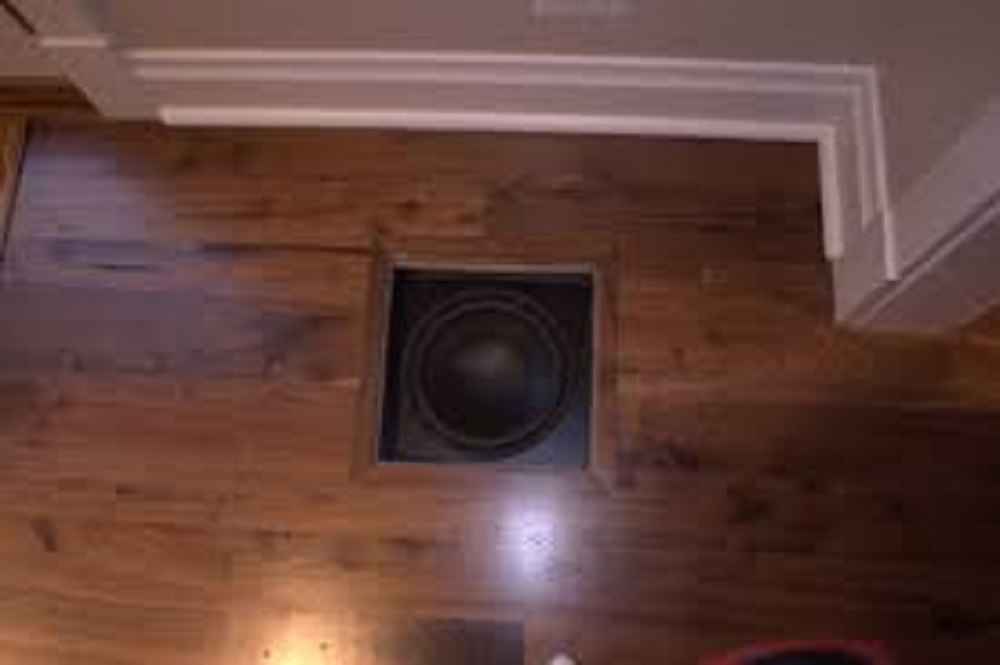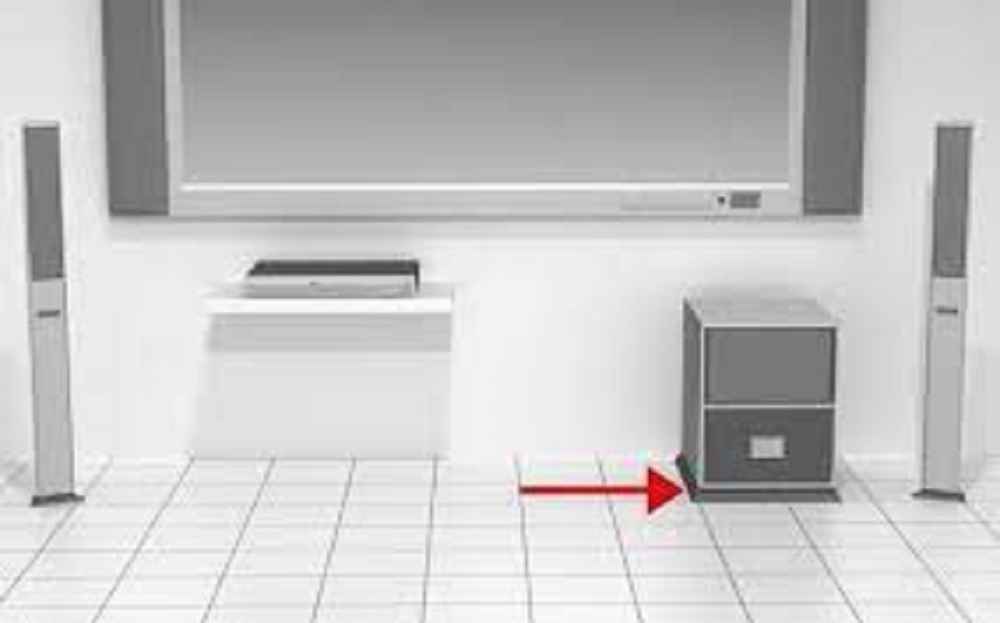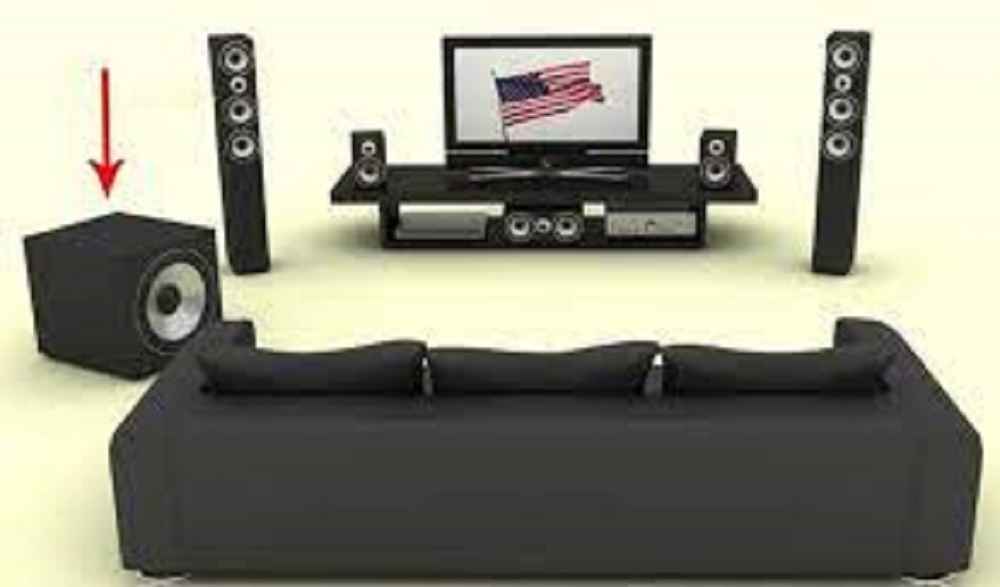A subwoofer is a speaker designed to reproduce low-frequency sounds, such as bass and drums, in home theaters and music systems.
These low-frequency sounds are essential to creating a full and immersive audio experience, and the placement of a subwoofer is crucial in optimizing its performance.

However, subwoofer placement is important if you want to get the best sound output from your home theater system. So, it is important to get the subwoofer placement right and know whether you should place your subwoofer on the floor or not.
In this article, we will discuss the benefits and drawbacks of floor-mounted subwoofers and alternative placement options.
Should A Subwoofer Be On The Floor?
Although you can place your subwoofer on the floor if necessary, this is not the best option. Ideally, your subwoofer should be elevated for the best sound output.
The main reason why you should not place your subwoofer on the floor is vibrations. Subwoofers generate lots of vibration while working.
If your subwoofer is placed on the floor, the vibration from the subwoofer will be transferred to the floor, causing the floor to vibrate. A vibrating floor and trembling room is not what you would like to experience with the entertainment.
Benefits of Floor-mounted Subwoofers
While placing your subwoofer on the floor is not recommended, placing your subwoofer on an elevated location isn’t also necessary. Nevertheless, placing your subwoofer on the floor has some benefits, which include:
Better Bass Response and Clarity:
By placing the subwoofer on the floor, the bass frequencies are allowed to develop and propagate in a more natural way, resulting in a clearer and more accurate representation of the original sound.
Increased Volume Potential:
A floor-mounted subwoofer can handle higher volume levels than a subwoofer placed on a shelf or table. This is because the floor provides a solid surface for the subwoofer to produce maximum bass impact.
Also, the subwoofer can’t fall off the floor due to vibrations.
Improved Aesthetic Appeal:
If well-paced, a floor-mounted subwoofer can blend in with the room’s décor, making it an attractive addition to a home theater or music system.
Enhanced Vibration and Impact of Bass Frequencies:
Placing a subwoofer on the floor allows for the transfer of vibration and impact to the floor, enhancing the overall sensory and immersive experience of low-frequency sounds. However, this largely depends on personal preferences.

Drawbacks of Floor-mounted Subwoofers
While floor-mounted subwoofers offer many benefits, it also has some drawbacks that should be considered.
Vibration and Noise Transfer to Other Rooms:
Placing a subwoofer on the floor can result in vibration and noise transfer to the floor and other rooms in the home. This may cause trembling and shock, which can potentially disrupt other activities within the home.
Possible Damage to Flooring and Furniture:
The vibration and impact of bass frequencies can cause damage to the flooring and furniture over time.
Impact on Room Décor and Furniture Placement:
A floor-mounted subwoofer can impact the placement of furniture and affect the overall appearance of the room, especially if it is not well-placed.
It may be necessary to rearrange furniture or make other modifications to accommodate the subwoofer and maintain the desired home décor.
Factors to Consider When Deciding Whether to Place a Subwoofer on the Floor
Before deciding whether to place your subwoofer on the floor or not, there are several factors to consider, which include:
The Size and Layout of your Room:
The size and layout of a room can affect the performance of a floor-mounted subwoofer. For example, a large room with an open floor plan may allow for better bass response, while a small room with a lot of furniture may result in a muddled sound.
Speaker and Furniture Placement:
The placement of speakers and furniture in the room can also impact the performance of a floor-mounted subwoofer. For optimal performance, the subwoofer should be placed in the center of the room and away from walls and corners.
Personal Preference and Desired Listening Experience:
Personal preference and the desired listening experience play a significant role in determining the best placement for a subwoofer. Some listeners may prefer a more pronounced and immersive bass presence, while others may prefer a subtler approach.
The Size of the Subwoofer:
The size of the subwoofer is also an important consideration when deciding whether to place your subwoofer on the floor or not. A large subwoofer may require a significant amount of space, which is only obtainable when the subwoofer is placed on the floor.
Alternative Placement Options for Subwoofers
If you do not wish to place your subwoofer on the floor, here are some alternative placement options to consider:
Wall-mounting:
You can mount your subwoofer on the wall to free up floor space and minimize the transfer of vibration and noise to the floor and other rooms.
However, wall-mounted subwoofers can be more difficult to install and may not provide the same level of bass impact as a floor-mounted subwoofer.
Corner-mounting:
This is similar to wall mounting. A corner-mounted subwoofer utilizes the walls and corners of a room to enhance the bass response and impact.
This placement option is best for small to medium-sized rooms and can be an attractive option for those who want to minimize floor space usage.
In-Cabinet or Under-Desk Placement:
An in-cabinet or under-desk subwoofer is tucked away, out of sight and out of mind. This placement option is best for those who want to maintain a clean and clutter-free appearance in the room.
Each of these alternative placement options has its own pros and cons, and the best option will depend on your specific needs, preferences, and available space.

Conclusion
In conclusion, the placement of a subwoofer is an important consideration in optimizing its performance.
Floor-mounted subwoofers offer many benefits, including better bass response and clarity, increased volume potential, improved aesthetic appeal, and enhanced vibration and impact of bass frequencies.
However, there are also drawbacks to consider, such as vibration and noise transfer to other rooms, possible damage to flooring and furniture, and impact on room décor and furniture placement.
Alternative placement options, such as wall-mounted, corner-mounted, and in-cabinet or under-desk placement, are also available for those who do not wish to place a subwoofer on the floor.
Ultimately, the best placement option for a subwoofer will depend on the individual’s specific needs and preferences, and it is important to experiment and fine-tune for the best listening experience.
Can a subwoofer be placed on a rug or carpet?
Yes, a subwoofer can be placed on a rug or carpet. However, it is important to ensure that the rug or carpet is thick enough to absorb any vibrations or impacts from the subwoofer, which can prevent damage to the flooring or furniture.
Additionally, it is important to make sure that the subwoofer is securely placed and will not slip or slide, especially when the volume is turned up.
Is it possible to place a subwoofer behind the couch or other furniture?
Yes, a subwoofer can be placed behind a couch or other furniture to hide it. This placement option can be a good way to minimize the visual impact of the subwoofer and to take advantage of the reflective surfaces of the furniture to enhance the bass response.
However, it is important to keep in mind that the subwoofer will still produce some amount of vibration, which may transfer to the furniture and cause movement or shifting.
What is the ideal distance between the subwoofer and other speakers in the room?
The ideal distance between the subwoofer and other speakers will depend on the specific system, room size, and individual preferences.
As a general rule, the subwoofer should be placed equidistant from the other speakers in the room and should be positioned in a manner that creates an equilateral triangle between the subwoofer, the listening position, and the main speakers.
Is it possible to place a subwoofer on an elevated platform or stand?
Yes, a subwoofer can be placed on an elevated platform or stand. This placement option can be a good way to minimize the transfer of vibrations and impacts to the floor and to improve the overall aesthetic appeal of the subwoofer.
However, it is important to ensure that the platform or stand is sturdy enough to support the weight of the subwoofer and to prevent any unwanted movement or instability.
What is the best way to optimize the performance of a subwoofer in a room with low ceilings or limited floor space?
For rooms with low ceilings or limited floor space, corner-mounted or wall-mounted subwoofers may be the best option. These placement options can make use of the reflective surfaces of the walls and corners to enhance the bass response and impact, and can also minimize the impact on floor space.
Additionally, in-cabinet or under-desk placement can be a good option for those who want to minimize the visual impact of the subwoofer.
